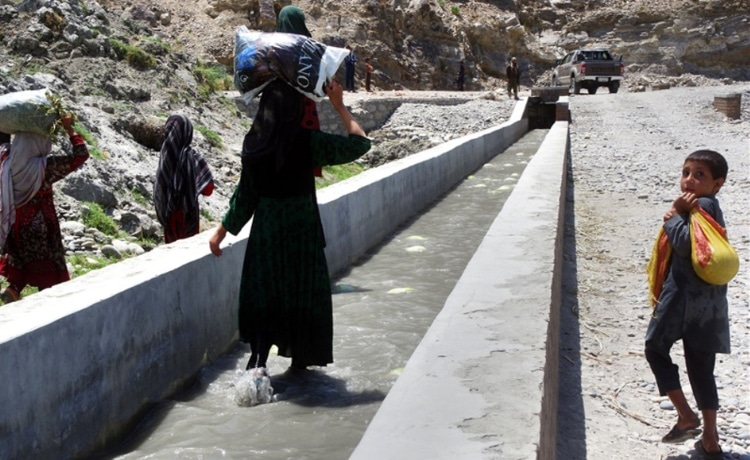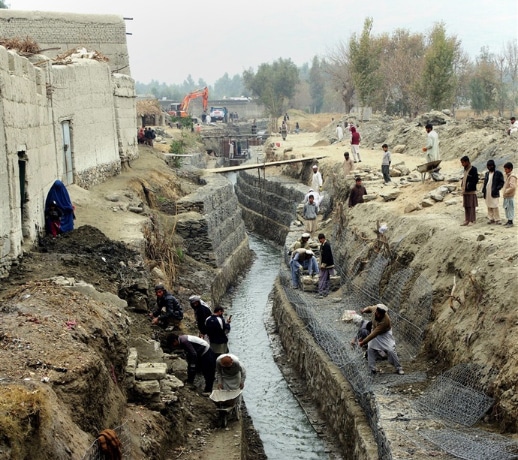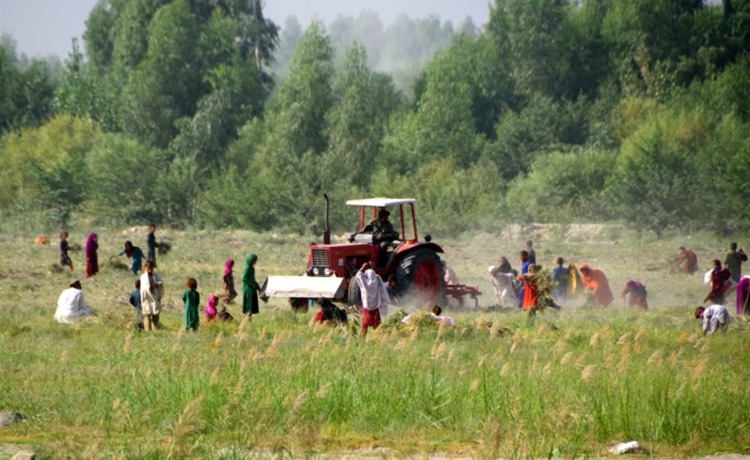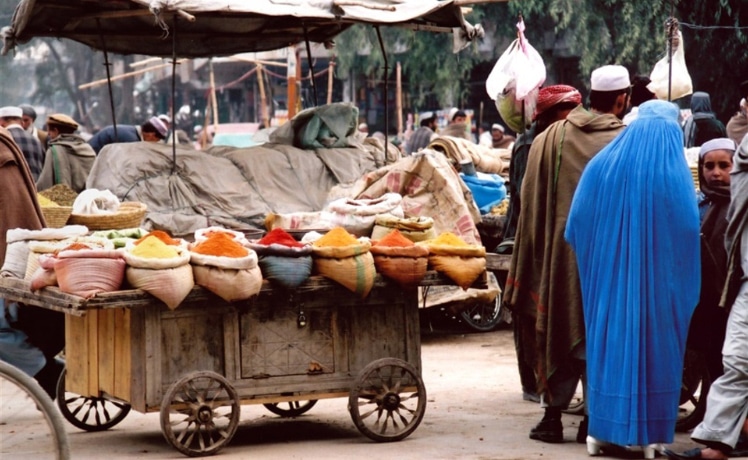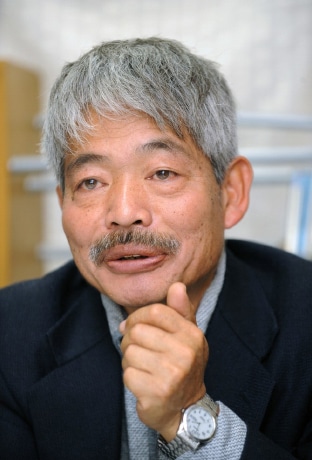【In the Land of the Afghans – Reports from Dr. Tetsu Nakamura】Women aspiring for survival and security
Published on June 17, 2019 – The Nishinippon Newspaper
People who listen to my lectures and read these articles often say, “Women do not appear in your reports.” There are reasons for this, though it is difficult for me to talk about them.
Shortly after US troops were stationed in Afghanistan in 2001, the problem of gender discrimination was intensely debated. Calls for women’s empowerment took center stage and things from school attendance rates to occupations for girls were also revised. “Islam’s backwardness” was vigorously criticized. United Nations (UN) agencies and international Non-Governmental Organizations (NGOs) in Afghanistan took the lead on this issue by increasing the percentage of females on staff.
Just prior to this, the policy of the former Taliban regime had been to ban schools for girls and restrict the employment of women, excepting female doctors. As it was during this time that gender discrimination was recognized as a global problem, campaigns by foreign organization in Afghanistan gained powerful momentum and seized hold of the issue. The atmosphere even shifted to one in which practicing Islam seemed to be condemned.
■A convincing approach
Peace Japan Medical Services (PMS) has put the concept of “Life and Water” at the center of its work, on a different track from the above-mentioned ways of thinking and cultural movements. After the arrival of the US troops, the common theme of most “Reconstruction of Afghanistan” campaigns was the so-called “modernization of the material and moral foundation of society.” However, as someone who had seen the reality of “the modernization process” since the Soviet invasion in 1979, those attempts felt familiar and I could not lend my unreserved sympathy and support for them.
For Afghans, Islam is in their blood and soul, a spiritual culture that disciplines every aspect of their lives. Within this cultural milieu, the idea of women’s advancement is not absent. This, however, should be discussed in the cultural terms that Afghan women themselves can relate to and accept, not as the result of pressure from outside. In addition, it felt uncomfortable for me to see people moving with the trend and pressuring the Afghans from a position of strength, during the deadly famine following the severe drought in 2000.
The area where we are providing support is in the midst of Pashtun (Pathan) society. It is the largest ethnic group in Afghanistan with approximately 20 million people and there are another 10 million Pashtuns in the northwest region of Pakistan, which makes them constitute one of the largest tribal societies in the world. There are several minority hill tribes in the region as well, but all of these groups live within the cultural sphere of the dominant Pashtun ethnicity. It is said by some that these people live in a society where “Watan (وطن / homeland / territorial connection) and Qomi (قومی / kinship) are the basis of everything.” Because of this strong tribal foundation, the rural farming villages are extremely insular and self-governed and are thus, largely unknown to outsiders.
■Campaigning against the burqa
When Pashtun women go out, they wear a burqa, which covers their entire body apart from the small mesh window over their eyes. There are strict rules governing gender segregation. In contrast to Japan where the punishment for forcing oneself on a woman can be passed off as a petty crime, in Afghanistan, it can normally result in the death penalty.
The burqa became a source of controversy when the Taliban, which consists mainly of Pashtuns, enforced its wearing in the capital city of Kabul. In the West the burqa soon became a symbol of “oppression against women” and a major campaign was launched in opposition. In Paris, statues were dressed in burqas to mock the outfit, and all kinds of headscarves were completely banned. However, burqas are nothing more than a typical form of overcoat worn when women leave their homes in eastern Afghanistan.
Originally, the concepts of what we know as “an individual” and “freedom” have never really existed in rural Afghan villages. In this society where kinship and territorial connections matter, ensuring the wider family unit’s security is of paramount importance. Men and women, as well as children, each has a unique role to play in their own society. The Soviet Union, which tried to usher in dramatic social change, met with strong resistance and left the country in chaos. On the other hand, the West fueled the conflict by supporting those resistance groups praising them as “Freedom Fighters” and making major arms shipments to them, that pushed the civil war into a quagmire. This Machiavellian position, where achieving objectives comes at any cost, led even the humanitarian assistance to be viewed with suspicion.
■Relieved from the toil of carrying water
Outside of large cities like Kabul, it seemed like women rarely made demands for their rights. For the speechless women living in rural villages, the heaviest burden is carrying water. Under the scorching sun, they sometimes have to walk many kilometers back and forth all day, carrying water jugs on top of their heads. As many springs have dried up recently, these women are forced to travel to a distant river to fetch water. However, as the water from the river is full of silt, it has to settle in a jar overnight before it can be used. This precious water is boiled and used for cooking and preparing tea. Since firewood is expensive, when locals become thirsty they often drink water from the river directly rather than boil it first. This means that fatal infectious diseases like dysentery and typhoid are easily contracted.
Our irrigation system has freed these women from the difficult chore of carrying water and the risk of contracting infectious diseases. In addition, all the wells around the irrigation canals were revived as groundwater levels rose and trees started to grow freely. Now water can be drawn with ease from a nearby canal and firewood can be provided from the trees that grow around. More than anyone else, women were the biggest supporters of the irrigation project. At the construction site, we often received children from the neighborhood delivering tea from their mothers. With no custom in place to speak casually with the opposite sex, housewives conveyed their appreciation through their children.
There was never any chance for us to talk to the women besides those times when they came to the clinic for treatment. Perhaps, their immediate survival was more important than attaining some abstract “rights” that you never know when you will acquire. First and foremost, demonstrating warm interest as a human being took precedence over the consideration of higher-level principles.
I believe that human rights exist for everyone to live well in harmony. Therefore, we will continue to appeal for the universality of blessings for them and their values, whether you are male or female, friend or enemy, or good or bad.
× ×
This is a translation of a report from Afghanistan by Dr. Tetsu Nakamura, a Japanese medical doctor who was gunned down on December 4, 2019 in Afghanistan at the age of 73. Dr. Nakamura was the head of the international NGO, Peace Japan Medical Services (PMS). In addition to medical services, PMS provides various forms of assistance to local communities in Afghanistan’s eastern Nangarhar province, including the construction of irrigation systems, related agricultural programming and provision of food support. PMS is funded by Peshawar-kai, which was established in 1983 to collect donations from people and support the project implementation of Dr. Nakamura and his team.
This report is one of 27 installments in the series “In the Land of the Afghans – Reports from Dr. Tetsu Nakamura,” which ran from May 25, 2009 to December 2, 2019. They were originally published by the local newspaper in Dr. Nakamura’s hometown in Fukuoka, Japan. The text has been translated from Japanese to English, with the support of Peshawar-kai, by more than 30 volunteers, many of whom work in the field of humanitarian and development aid, and who have been and will continue to be inspired by Dr. Nakamura's work and philosophy.


